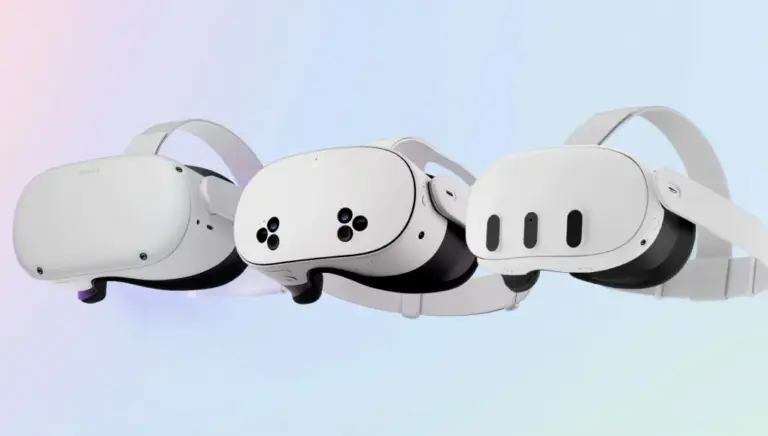Meta Quest Comparison: Key Differences Between Meta Quest 3 and Meta Quest 3S
Introduction to the Meta Quest Series
The Meta Quest Comparison starts with two standout models: the Meta Quest 3 and the Meta Quest 3S. Both are remarkable standalone VR headsets, but they cater to different needs. The Quest 3 is equipped with advanced color pass-through cameras, boosting its augmented reality features. In contrast, the Quest 3S offers similar capabilities at a more budget-friendly price, though it compromises slightly on picture quality. This blog will explore the key differences and features, guiding you in making an informed decision about which model suits your needs best.
Meta Quest Comparison: Price Comparison of Two Models
When we dive into a Meta Quest Comparison, the most apparent difference is the price. The Meta Quest 3S starts at a tempting $299.99, matching the launch price of the Quest 2. It provides a storage choice of 128GB, with an upgrade to a 256GB variant available for $399.99. On the flip side, the Meta Quest 3 is priced at $499.99 and features a generous 512GB of storage. This clear price distinction makes the Quest 3S an attractive choice for those seeking a combination of affordability and functionality.
Design Elements: A Closer Look
In terms of design, both headsets are visually similar, showcasing a white plastic casing along with a Y-shaped head strap. Users looking for added comfort can opt for the three-point Elite Strap. However, the front design differs; the Quest 3 features a more rounded front, while the Quest 3S comes with a flatter front face. While these design features might seem purely cosmetic, they do not greatly influence the overall user experience.
Display Features: Quality Matters
Looking at the visual capabilities, the Quest 3S offers a reduced display quality. Its resolution measures at 1,832 by 1,920 pixels per eye, resulting in 773 pixels per inch. In contrast, the Quest 3 surpasses this specification with a resolution of 2,064 by 2,208 pixels per eye, yielding a clear 1,218 pixels per inch. Both models support refresh rates of 72Hz, 90Hz, and 120Hz. Additionally, the Quest 3 boasts a wider field of view at 110 by 96 degrees compared to the Quest 3S’s 96 by 90 degrees, enhancing the immersive virtual reality experience.
Meta Quest Comparison: Cameras and Augmented Reality Capabilities
Both headsets are outfitted with color pass-through cameras, allowing users to engage with their environment in full color. This feature is crucial for augmented reality applications and maintaining a connection to the physical world. Each headset comes with identical 4MP cameras, marking a significant advancement from the Quest 2. However, neither model reaches the visual fidelity found in high-end devices, like the Apple Vision Pro.
Processing Power: Same Great Performance
When it comes to processing performance, users will find a striking similarity in both models. They are powered by the Snapdragon XR2 Gen 2 processor along with 8GB of RAM. This powerful chip is tailored for mixed reality applications, guaranteeing that both the Quest 3 and Quest 3S deliver smooth and responsive performance during immersive virtual experiences.
Motion Tracking and Controls: Consistency Across the Line
Users will benefit from similar motion tracking capabilities in both the Quest 3 and Quest 3S. They utilize outward-facing cameras that effectively track head and controller movements. The Meta Quest Touch controllers provide limited hand-tracking support, contributing to a consistent and user-friendly design across the board.
Battery Life: Comparing Performance
Battery life presents another noteworthy point of comparison. Although the Quest 3S is equipped with a smaller battery, it still manages competitive performance to the Quest 3. The Quest 3S features a 4,324mAh battery versus the Quest 3’s robust 5,060mAh battery. However, because of its lower resolution display, the Quest 3S can last roughly 2.5 hours on a single charge, whereas the Quest 3 has a slightly shorter runtime of 2.2 hours. Thus, in certain usage scenarios, the Quest 3S may offer longer playtime.
Storage Capacity: Making Your Choice
Storage capacity remains an important consideration when comparing models. The Quest 3 offers a generous 512GB of storage, while the Quest 3S is available in two options—128GB and 256GB. Users should take their storage needs into account, especially if they plan to download a variety of games or applications.
Software and Ecosystem: A Consistent Experience
The software functionality is consistent across both headsets, as they operate on the same Meta VR platform with an extensive library of games and applications. Both models can connect to PCs for SteamVR and other desktop-based games, although separate purchasing of the Meta Quest Link Cable will be required to enjoy these features.




0 Comments